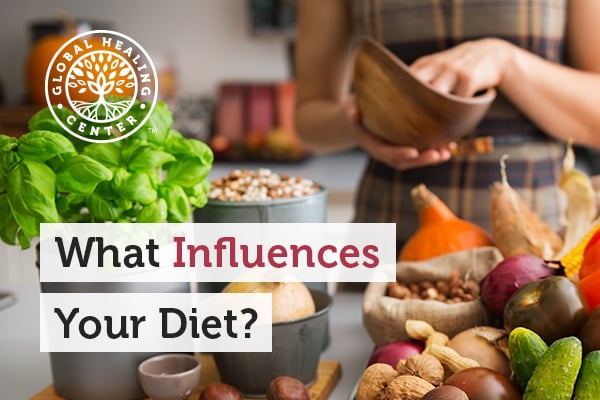
How do you decide what to eat? Think about what influences your decision. Nutrition, taste, health, cultural preferences and taboos, regional specialties, availability, personal preference, dietary restrictions... advertising? All of these can play a part, but for now, let’s focus on that last one.
Food is a big business. Let's face it - everyone has to eat. What we choose to eat, however, can vary significantly depending on how food is presented to us. There are a couple of ways this works. Let’s take a deeper look.
Falling for Fad Diets
Fad diets are a common example of how marketing and advertising can influence the public’s decisions about nutrition. Fad diets tend to be strategically created by influencers, food manufacturers, and even government agencies to increase sales by convincing the general public that certain ingredients or products are good (or bad) for them. Unfortunately, the message delivered to the public isn't always completely accurate.
What Are Fad Diets?
A fad diet is an unhealthy and unbalanced change in eating behavior that promises to achieve some goal, usually rapid weight loss. Most fad diets promise extreme weight loss, often more than 1-2 pounds per week.[1] Unfortunately, some reflect a misunderstanding of dietary necessities. An example would be the low-carb diets that have become so popular in recent years. They are touted as a breakthrough, even though the body actually relies on carbohydrates as a major source of energy.[2]
In reality, there are many types of carbohydrates — some bad, some good.[3] The issue with low-carb diets is that they don’t distinguish between the different types of carbs. Some people don’t know enough to responsibly determine which carbohydrates they should or shouldn’t eat, so they just eliminate carbs altogether. This is a bad idea because it leaves the body short on essential nutrients.[4]
Unfortunately, many fad diets pick up speed when food manufacturers promise health benefits that their products may or may not (usually not) be able to deliver. The claim is usually the same – it's the quick and easy way to see drastic results in a relatively short period of time, but do they work?
Do Fad Diets Work?
Fad diets almost never work. The National Institute of Diabetes and Digestive and Kidney Diseases has said that fad diets simply won’t keep the weight off for long.[5] Weight loss has to be a long-term, sustained effort.[6] The speed of the weight loss shouldn’t be a factor.[7] Fad diets require changes to eating habits that are almost never sustainable.[8] Once a person goes back to regular eating habits, they’re almost certain to regain weight.[7]
Once these fads become well-known and trendy, food manufacturers smell an opportunity and begin to produce foods that cater to these dieters. This niche audience is far more likely to buy these products than the general public. Once the hype starts, the audience grows. Think about it, have you ever changed, or intended to change, your eating habits because you were told something was healthy? It happens all the time and is just one more way that the big food companies influence how and what we eat. Let's explore another.
Villainizing an Ingredient
Sometimes big food companies create marketing messages designed to convince consumers that certain things are unhealthy. They claim that their products are better than a competitor's who may contain the ingredient(s) in question. What can make this misleading is that the overall nutritional value of these products is usually ignored during the decision-making process. Consumers are told only to avoid a specific ingredient, with no thought about the other ingredients.
As an example, think about sugar. How often do you see the words "sugar-free" written on food packaging? The companies who produce these foods may try to convince consumers that all sugar is bad so that the consumers will be more likely to choose their product. Again, this is misleading because there's more to consider than sugar. While it is true that refined sugar is bad, many sugar-free products use dangerous artificial sweeteners like saccharin or aspartame. In many ways, artificial sweeteners are even worse than sugar! They've been linked to weight gain, brain and bladder cancer, and other health concerns.[9]
Another growing trend has been to use agave nectar in place of sugar or artificial sweeteners. Because agave nectar has become so popular, though, there are unscrupulous manufacturers are churning out low quality, fraudulent agave products that are more similar to high fructose corn syrup. Consumers who are trying to avoid the negative health effects of sugar may be surprised to learn that the supposedly healthier agave nectar is anything but.
Balancing Risk and Reward
In situations like this, it's important to remember that sugar itself is not the concern. The excessive amounts of added refined sugar in the average American diet are the real issue. There are plenty of healthful foods like apples, strawberries, carrots, and sweet potatoes that contain natural sugars (and a lot of nutrients, especially when organic). Even still, many food producers work to convince consumers that all sugars are unhealthy and, unfortunately, many consumers believe it. However, when it comes to proper nutrition, there has to be balance.
Our bodies cannot function without proper nutrition, so the main purpose of our diet should be to nourish our bodies. Many foods, no matter what the packaging may claim, offer more risk than reward. Foods like white flour are not good because many minerals, vitamins, and phytonutrients are lost during the refinement process.[10] Making informed decisions is one of the best ways to ensure that you're taking proper care of your body and it all starts by developing a better understanding of nutrition facts and food labeling.
What You Need to Know About Nutrition Facts Labels
According to the United States Food and Drug Administration, there is a right way and a wrong way to read Nutrition Facts labels.[11] Checking the serving size should be your first step. Being aware of serving sizes provides perspective and sets expectations about how much of a food you should consume. The next thing to look at is the calories, especially the calories from fat. This represents the number of calories your body will burn as energy vs the number of calories that will be stored as fat. Fat calories tend to stick around.[12] The third part of the label that you should consider is the ingredients you want to limit. These are things like fats, cholesterol, sodium, and carbohydrates. Next, evaluate the nutrients you need — vitamins, minerals, and protein. Make sure you get enough of these. The “% Daily Value” column can help. There is a “footnote” at the bottom of food labels to help you understand the daily values. It’s a good point of reference to help you measure your diet based on 2,000 or 2,500 calories per day restrictions.
Above all else, read the ingredients. Watch out for synthetic junk like dextrose, corn syrup, aspartame, sucralose, saccharin, etc. Avoid anything that sounds artificial. If you’re unfamiliar with an ingredient, I suggest performing a little researching. It could be a natural ingredient with an exotic name, but it could also be a toxic additive. If you aren't sure how to make sense of food labels, the FDA provides additional information and resources to help you make better decisions.
As you make more informed decisions about what to feed your body, make sure you're choosing foods that work together and support your goals. If you're hoping to lose weight, try a low-calorie diet of organic-plant-based foods. These will be a lot more likely to aid in your weight loss than high-calorie processed alternatives.
Realize that everyone’s health goals are different and those goals have a tremendous influence over diet. For example, a person who regularly participates in athletic activities will have different nutritional needs than someone who is relatively sedentary.[13] This is where the individual factor becomes so important. Set clear nutritional goals for yourself. Understand exactly what you’re trying to accomplish with your diet. Are you trying to lose weight? Bulk up? Gain more energy? Setting achievable goals will help prepare you to make better dietary decisions based on reading nutrition labels.
What Does it Mean to Be Healthy and Well?
At Global Healing, we have a unique way of defining wellness. It all begins with the understanding that the body has self-healing mechanisms that help it thrive. Health and wellness are really about making sure that the body’s systems are functioning properly. This, in turn, will help the body to take care of itself and encourage a long, happy life. Your diet plan determines what you bring into your body, so it's a critical part of health and wellness. I recommend trying my body cleansing diet, which will help support your health by providing the nutrition it needs. Don't let big food producers hamper your efforts to be healthy with misleading messages about what you should eat. Understand what your body needs and decide for yourself. Your health relies on your body, and your body depends on nutrition.
References (13)
- Familydoctor.org Editorial Staff. "Nutrition for Weight Loss: What You Need to Know About Fad Diets." FamilyDoctor.org. The American Academy of Family Physicians Foundation, Feb. 2004. Web. 22 Mar. 2016.
- "Protein, Carbohydrates & Fats." National Institute on Aging. U.S. Department of Health & Human Services, n.d. Web. 22 Mar. 2016.
- "The Truth about Carbs." NHS. Gov.uk, 22 Sept. 2014. Web. 22 Mar. 2016.
- Manninen, Anssi H. “Metabolic Effects of the Very-Low-Carbohydrate Diets: Misunderstood ‘Villains’ of Human Metabolism.” Journal of the International Society of Sports Nutrition 1.2 (2004): 7–11. PMC. Web. 22 Mar. 2016.
- "Weight-loss and Nutrition Myths." National Institute of Diabetes and Digestive Health. U.S. Department of Health & Human Services, n.d. Web. 22 Mar. 2016.
- "Keeping It Off." Centers for Disease Control and Prevention. U.S. Department of Health & Human Services, 15 May 2015. Web. 22 Mar. 2016.
- "Diet Myths and Facts." MedlinePlus. U.S. National Library of Medicine, 28 May 2014. Web. 22 Mar. 2016.
- Porcello, LA. "A Practical Guide to Fad Diets." Clinical Sports Medicine 3.3 (1984): 723-29. PubMed. Web. 22 Mar. 2016.
- Tandel, Kirtida R. “Sugar Substitutes: Health Controversy over Perceived Benefits.” Journal of Pharmacology & Pharmacotherapeutics 2.4 (2011): 236–243. PMC. Web. 22 Mar. 2016.
- Jonnalagadda, Satya S. et al. “Putting the Whole Grain Puzzle Together: Health Benefits Associated with Whole Grains—Summary of American Society for Nutrition 2010 Satellite Symposium.” The Journal of Nutrition 141.5 (2011): 1011S–1022S. PMC. Web. 22 Mar. 2016.
- "How to Understand and Use the Nutrition Facts Label." U.S. Food and Drug Administration. U.S. Department of Health & Human Services, June 2000. Web. 22 Mar. 2016.
- "Dietary Fats Explained." MedlinePlus. U.S. National Library of Medicine, 12 Aug. 2014. Web. 22 Mar. 2016.
- "Nutrition and Athletic Performance." MedlinePlus. U.S. National Library of Medicine, 25 Apr. 2015. Web. 22 Mar. 2016.
†Results may vary. Information and statements made are for education purposes and are not intended to replace the advice of your doctor. If you have a severe medical condition or health concern, see your physician.







